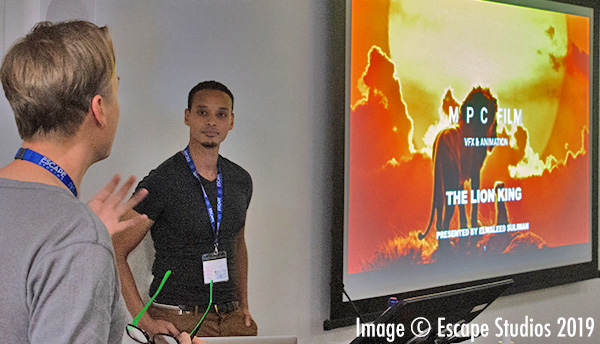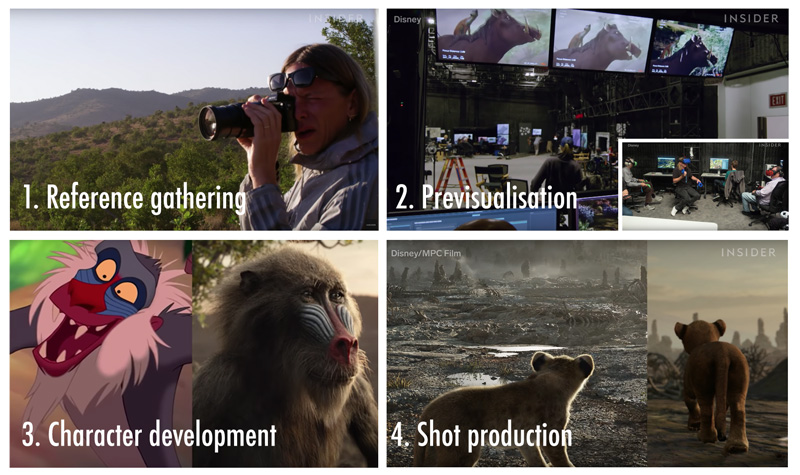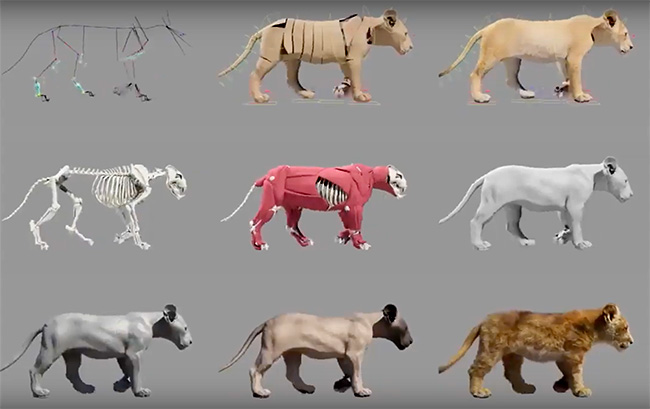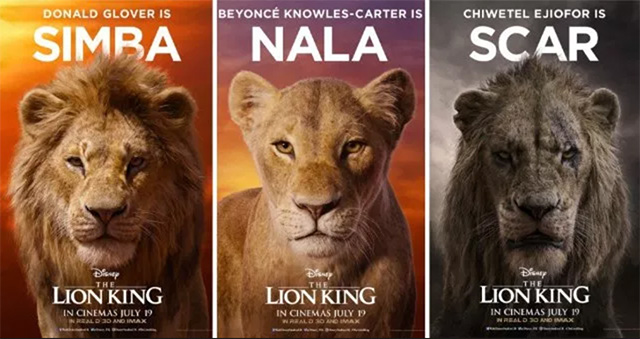
Escape Studios regularly have industry guests giving huge insights into an aspect of animation production. I attended one recently about MPC’s work on the Lion King given by El Suliman who was one of the lead animators on this film.
The Lion King (2019) is, at the moment, heading a trend of animated realism, of which there will be more in the future. The director, John Favro, was testing this level of realism in his previous film Mowgli: Legend of the Jungle (2018), and in this new version of Lion King wanted to move it forward into a completely believable wildlife documentary style film. It’s a form of animated realism that aims to stay firmly out of the uncanny valley by being as true to real life as live action. This kind of realism is a trend in animation right now and there will be more like this, but is only a trend like any other. Into the Spider-Verse (2018), for example is following another trend. El Suliman explains how they achieved this look, in his talk summarised here.
“If we had this magic potion in 1993 we would have used it”, Alex Williams worked on the original Lion King (1994) back in ’93, whilst introducing El Suliman he reminisced that the toughest scene was Scar scattering the hyenas, but he is in awe of the level of complexity in this version of the film.
El Suliman was one of the leads for this film at MPC. The most challenging shot for him was animating Simba running with the Wildebeest at the start of the film. It took 3 months to animate and, he says, was very stressful.
The four stages to produce realism in animation
- Reference gathering
- Previsualisation and virtual reality production
- Character development
- Shot production
These stages overlapped at times but they are all needed for the final result.

1. Reference gathering
15 people went to Kenya to shoot animals, foliage and landscapes. The brief was that the film should look like a David Attenborough film, so they needed to find the right environments to shoot from which they could build the digital set. Using helicopter, vehicles and exploring on foot they were able to shoot 42 hours of reference footage to get a deeper understanding of the animals and landscape for the film.
They spent time with the animal keepers and handlers in the Disney Zoo, and Colchester Zoo, to learn about the character and habits of the animals. They gathered 7’000 reference videos so that every animated animal movement could be checked against a live action video of that animal doing the same movement.
You can get a real feel of this wildlife documentary style in this trailer, and you can also see the only live action shot in the film at the start, which was shot during this reference gathering stage Kenya:
2. Pre-visualisation and virtual reality production
There are no matt paintings in this film. They created the entire world in CG. This allowed them to create a 3D set in Virtual Reality so that the DP could walk about inside this VR space and place the camera where they wanted just as they would in a live action set. Added to this the CG camera was designed to replicate the lens of a real camera so that the end result would feel exactly like a live action shot.
This meant that entire sequences could be generated instead of the traditional method of working shot by shot. These pre-viz shot sequences could be 10 minutes long, and shot with VR cameras on drones, flying around the CG pre-viz space. Although this frees up the film to be made more like a wildlife documentary, it makes the animated sequences far more challenging to make, as now teams are working on long and complex sequences, rather than more contained shots.
This virtual production stage took about 1 year, and there was 150 square kilometres of full CG world created for the film, over 66 digital sets.
3. Character development
As you can imagine developing character in a hyper real film is a special challenge, as animators tend to rely on exaggerating movement and facial expression to instil personality.

There are 86 different species of animal in the film, and MPC created every single creature. Every creature was built from it’s skeleton upwards, muscle layers, skin, fur/feathers. Each skeleton was checked with vets and animal experts to make sure that they were rigged correctly. When the rigged CG animal was animated, this animation was checked against the real live action reference video for accuracy. 130 creatures in total had to be checked for accurate movement across their face range (is the face moving accurately), walk cycles, run cycles, flight cycles (is the walk, run or flight accurate compared to the reference footage). Even the grub!

Then comes the challenge of instilling character. This can only be done with posture, gait, speed, and control, and in some animals the subtle use of eyebrows. So an older animal might be slower, more plodding, at the start Simba has a slight strut in his walk. Each animal then had to be checked by Disney for personality with accuracy of movement.
Scar was the hardest character to get right, although they had to stay anatomically correct they did actually have to alter his head shape to enhance his personality, and of course altering his movement to suit his character.
Traditionally video footage of the voice actor is used to create a reference for facial expression for lip synch. But in this film they were able to use the body language as a reference instead to maintain the documentary feel. The Mandrills however had eyebrows that could be used for expression.
The facial expression restrictions made it very hard to convey expression. At the start this was a challenge for the animators, who were used to using expressive movement, but after a while they learnt to adapt to depending on body language and some eyebrow use. If the movement was not completely convincing, the film would shift into the ‘Uncanny Valley’.
Animating the speech was done using a Facial Action Coding System (FACS), which means that all the movements are generated from scratch, not using the traditional phonemes system which creates a library of mouth shapes for different sounds.
4. Shot production
The environments in the films are actually the biggest star, they were massive and created real challenges for the animators. For example the entire stampede sequence took a year to make, as every Wildebeest needed to be hand keyed. There are crowd systems that can generate crowds (Alice), but not on this challenging terrain. The Wildebeest have 250 run cycles to build up their movements, these cycles are alternated so that there will not be a single Wildebeest with the same run cycle in the same shot. But to create these cycles took 3 to 4 animators, 3 to 4 months to make.
Insider channel has an interesting film here which amongst other things talks about hair simulation to make sure the shots are completely believable.
The ‘Hero Shots’ were all animated from scratch, whereas the background characters movements are built out of movement libraries. This means each background creature has a library of movements, cycles and actions, than can be called on and altered or adapted to build up action in the shot.
The only shot in the film that is not CGI is the sun rising in the opening shot, and it’s a real time sun too! (You can see this shot at the start of the trailer shown previously)
As well as the animals mentioned in the previous section there were also 921 environment assets including 25 tree species, 49 plant species and 18 grass species built to populate the environments.
In this VFX breakdown you can see the various stages of character and environment build as well as the final composite and colour stages.
Making the film
John Favro is a very hands on Director, although he was in LA for most of the production, he would do reviews by Skype, and make regular visits to the studio. He would visit every single department, and shake hands with every single person, showing appreciation to artists who normally rarely get to meet the director. John does a live presentation to every part of the team on his vision for the film, talks directly with people and is a fountain of knowledge on every aspect of how things should be in the film.
He talks about animators using online video reference footage for their animation, and I have been building a video reference for animators here in this play list. I’m starting with birds.
In summary there were 1150 artists from 30 nations, as well as 130 animators, the bulk of which were in the UK, 80 of them were are MPC. Also 50 software developers. This is all to make the 1500 shots in the film.
At MPC both juniors and experienced animators all got to work on the Hero Shots. These shots are shared to develop the juniors and keep everyone moving forward. There were specialist classes on specific movements, like foot movement, quadruped movement, herbivores and carnivores.
There are some pivotal moments in the original film that are referenced by this remake, for example Simba looking into the water. It’s not meant to be a totally different film, the original is referenced but there was freedom to remake it in a whole new way.
Buy the DVD of the 2019 Lion King

(As an Amazon affiliate I earn from qualifying purchases)
Buy the DVD of the 1994 Lion King

(As an Amazon affiliate I earn from qualifying purchases)
Disney broke new ground in many ways in this new remake of the film, even the opening night did so with a 5G live stream of the event.
Please comment
What’s you view on animated realism? Are you a fan of it or do you prefer the more cartoon style animation?
Do you think young children might think that animals actually behave like this, will it bring them closer to feeling emotionally engaged with the wildlife on our planet?
What would be your preference for making animation? Would you enjoy the challenge of making realism, or would you enjoy working with the more expressive style of animation?
Please leave your views below. Thank you.

Great and excellent article. The film is awesome, and to see how the lion character was built and the behaviour created. I got to know from your awesome post that there are 86 different species of animal in the film, and MPC created every single creature. Every creature was built from it’s skeleton upwards, muscle layers, skin, fur/feathers, this is great, this is very educational to me. I love reading and re-reading your article again. Thanks for sharing.
Thanks for the comment Abayomi. Yes many people are not aware of how each animal is created in an animated movie. Even stylised 3D animated characters (like Zootpia) are made the same way, it’s just that the details in this new Lion King have to be really accurate to nature, so they are more complex to build and animate. Glad you liked the article, the movie clips are really good, because they explain very well too. Thank you.
Hello
Very interesting your article
“Lion King” from reading the article first I understand how difficult it can be to get this movie rolling
Sure enough, they spent time with animal owners and operators at the Disney Zoo and the Colchester Zoo to learn about the character and habits of animals.
There are 7’000 videos that says it all
Another thing that impressed me was the detail he uses for the 130 creatures and the precision of the movement and the character of the person
Thanks so much for sharing
Thank you for your comment Water Life. To be honest all animated films are challenging to make, each have there own unique set of challenges. This talk showed the level of study that went into understanding the animals they had to animate, which is nice to illustrate. But even the animators of drawn animation will study the animals and people that they are animating.
Wow! I just knew it that this movie is not ordinarily made. I had to ask my partner if it was a NatGeo wild channel presentation we were seeing when I went to the cinema to watch this movie. It was simply so realistic. The animation was simply a masterpiece and more than anything I have ever watched before. I really do hope that more animated movies can be made using this same technologies. It is very interesting to read about it
Great thanks for the comment Roland. Nice to hear from a fan of animated realism. I think there will be more of this style of animated film in the future, in his talk El did identify it as a current trend. Interesting to hear you say that you didn’t at first realise it was animated. I wander what children will make of it!
Wow, I knew making animated realism is quite difficult but it is more difficult than I thought it would be. Talking about the Lion King I must confess I am very impressed by the level of realism attained by the producers of this movie. Taking these measures mentioned here just to put up a realistic piece is quite astonishing, a very good work they did there. And also, thanks for this wonderful post on how animated realism is achieved.
Thank you for your comment Chloe. My pleasure to share! It is astonishing what goes into making all animated films, including this type. This film is certainly the most accurate animated realism achieved so far, and throughout the entire film, not just a part of it! Thanks, glad it’s helped you appreciate it more now.
This is very informative. I’m happy to see that the movie industry is taking a new turn and new technology is being brought into the party. I like the fact that there was so much realism. While watching the movie, I was thrilled to see how awesome the remake was. It’s good to learn the steps that it took to make the movie, it was a big baffle to me. I didn’t know they went to Kenya to do some shootings. I hope to see more realism in the future as I am already falling in love with it.
Thank you for your comment Henderson. Interesting to see that so far everyone loves the realism. Yes the movie industry is embracing any new technology it can to overcome challenges, like using VR to create a virtual space in which to move the camera around, just as if it was a real camera. I can see this animated realism is a trend with a hungry audience! Thank you
Wow! It is insanely incredible the amount of work put into this type of movie. I grew up watching loads of cartoon-style animated movies. Of course, with the evolvement of technology, animated movies (to say it in plain terms), get better and better. The realism of it appeals to all generations. Knowing the detailed works that need to be done in this movie, make me appreciate the movie more. Same goes to all the people who worked so hard for it.
Thanks for posting this, Lucy.
Thank you for your comment Sharon. Yes there is a lot of work that goes into all animated movies, but this one sounds especially stressful for the animators as they had to learn a whole new approach to building personality into a character being able to use the traditional approaches. Glad this has helped you to appreciate the movie more now!
It’s amazing the amount of people and effort that made this great animation possible, Every creature moves with seeming weight and realism, every landscape looks straight off a postcard. The African night sky is rendered so realistic, with so much work I’ll say the the visuals alone are enough to justify the remake. I love every bit of this animation, different visual same story.
Thank you Seun Jeremiah, for your comment. Glad you picked up on the weight of each creature, that is a big part of getting any animated character to be believable. Yes the landscapes are amazing. Like El said in the talk, the landscapes are the true stars of this film! Glad you appreciate the visuals as being enough of a justification to remake the story. Some would say that there are no new stories in Hollywood so they keep remaking the old ones, but if a story is great, why not remake it with different visuals so that we all have an excuse to go and watch it again! Thank you.